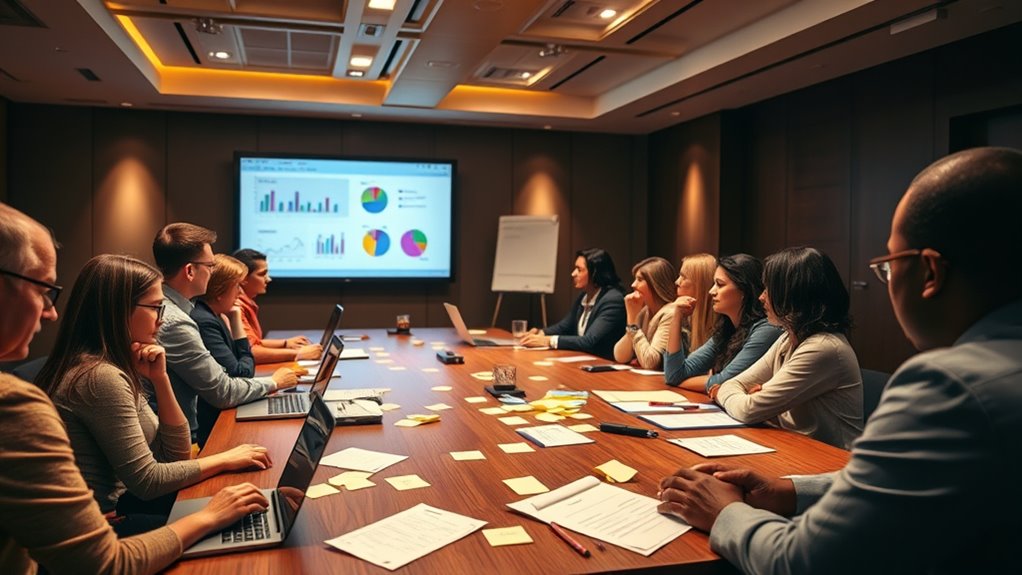To effectively gather and document feedback after an event, start by distributing surveys through email, social media, or event apps, making it easy for attendees to share their thoughts at their convenience. Incentivize participation with small rewards to boost response rates. Analyze the responses for patterns, highlighting strengths and areas needing improvement, then compile your findings into clear, actionable insights. Continuing with these strategies will help you enhance future events and improve overall attendee satisfaction.
Key Takeaways
- Distribute surveys via email, apps, or social media for convenient attendee feedback collection.
- Use incentives like discounts or prizes to encourage survey participation and honest responses.
- Analyze responses to identify patterns, strengths, and areas needing improvement for future events.
- Summarize raw feedback into clear insights using tools like spreadsheets or software for better understanding.
- Share findings with the team, incorporate improvements, and track progress across multiple events.

Have you ever wondered how to improve your events and better understand your attendees’ experiences? The key lies in effective post-event feedback collection. After an event wraps up, gathering insights from your attendees helps you identify what worked well and what needs improvement. One of the most efficient ways to do this is through virtual surveys. These digital questionnaires are convenient for both you and your attendees, allowing people to share their thoughts at their own pace and comfort. Virtual surveys can be easily distributed via email, event apps, or social media, making it simple to reach your audience regardless of where they are. They also enable you to collect quantitative data, such as ratings and rankings, alongside qualitative comments, providing a thorough view of attendee satisfaction. Incorporating feedback tracking into your process can help you monitor trends over multiple events. To maximize participation, consider offering feedback incentives. Incentives motivate attendees to take the time to complete surveys, increasing response rates and ensuring you gather enough data to make informed decisions. Incentives don’t need to be extravagant; even small rewards like discount codes, gift cards, or entry into a prize draw can greatly boost engagement. When you combine virtual surveys with thoughtful incentives, you demonstrate that you value your attendees’ opinions, encouraging honest and detailed feedback. This approach helps you build trust and shows that you’re committed to continuous improvement. Once you collect the feedback, the real work begins. Carefully analyze the responses to identify patterns and key themes. Look for areas where attendees expressed high satisfaction and note the aspects they found lacking. Summarize the data in clear, actionable insights rather than overwhelming yourself with raw responses. Documenting this information systematically allows you to track progress over time and compare results from different events. Use tools like spreadsheets or specialized feedback management software to organize your findings effectively. Sharing your results is also essential. When appropriate, communicate the summarized feedback to your team and stakeholders. Transparency about what you’ve learned fosters a culture of ongoing improvement. Furthermore, sharing positive feedback can boost morale, while addressing concerns demonstrates your commitment to enhancing future events. Incorporate the insights into your planning process, adjusting logistics, content, or engagement strategies based on attendee input. In essence, collecting and documenting post-event feedback through virtual surveys and feedback incentives creates a cycle of ongoing enhancement. It gives you direct insight into your attendees’ experiences, helping you tailor future events to meet their expectations. By systematically analyzing and acting on this feedback, you not only elevate the quality of your events but also strengthen your relationship with your audience, ensuring they feel heard and valued every step of the way.
Frequently Asked Questions
How Soon Should Feedback Be Collected After the Event?
You should collect feedback as soon as possible after the event, ideally within 24 to 48 hours, to guarantee timely insights. This timing considers participant responsiveness, which tends to decline over time, making responses less accurate. Prompt collection helps capture fresh impressions, providing valuable data for evaluating success and identifying improvement areas. By acting quickly, you maximize the quality and usefulness of the feedback received.
What Tools Are Best for Anonymous Feedback Collection?
Like a hidden gem, anonymous surveys and feedback apps shine when gathering honest insights. You should use tools like Google Forms, SurveyMonkey, or Qualtrics for anonymous feedback collection. These platforms protect identities, encouraging open, candid responses. They’re easy to set up and analyze, making your post-event review more thorough. Trust these tools to give you genuine feedback, helping you improve future events without fear of bias or reprisal.
How to Handle Negative Feedback Constructively?
When handling negative feedback, you should view it as constructive criticism to improve future efforts. Stay calm and practice emotional resilience, avoiding defensiveness. Listen carefully, acknowledge the feedback, and ask clarifying questions if needed. Use it as a growth opportunity, taking actionable steps to address concerns. This approach not only enhances your skills but also demonstrates professionalism and openness, turning challenges into valuable learning experiences.
Can Feedback Collection Impact Future Event Planning?
Feedback collection is the compass guiding your future event planning, directly impacting your success. When you prioritize timely feedback and foster participant engagement, you gather insights that illuminate the path forward. This real-time input helps you adapt strategies, improve attendee satisfaction, and avoid pitfalls. By actively listening and acting on feedback, you turn every event into a stepping stone for continuous improvement, making each subsequent event more tailored and impactful.
How to Encourage Hesitant Participants to Share Their Thoughts?
To encourage hesitant participants to share their thoughts, start with engaging icebreaker activities that create a relaxed environment. Use incentivizing participation by offering small rewards or recognition, making them feel valued. You can also ask open-ended questions gently and assure confidentiality. By fostering trust and making sharing fun, you’ll help even the most reticent attendees feel comfortable contributing their feedback, enriching your post-event insights.
Conclusion
As the echoes of the event fade and the last attendee departs, you gather the scattered notes and digital responses like delicate leaves in your hands. Each piece of feedback paints a vivid picture of what worked and what fell short, guiding your next steps. By capturing these insights, you’re weaving a tapestry of growth and improvement, ensuring future gatherings are even more inspiring. Remember, every detail, no matter how small, helps shape a brighter, more memorable experience.









